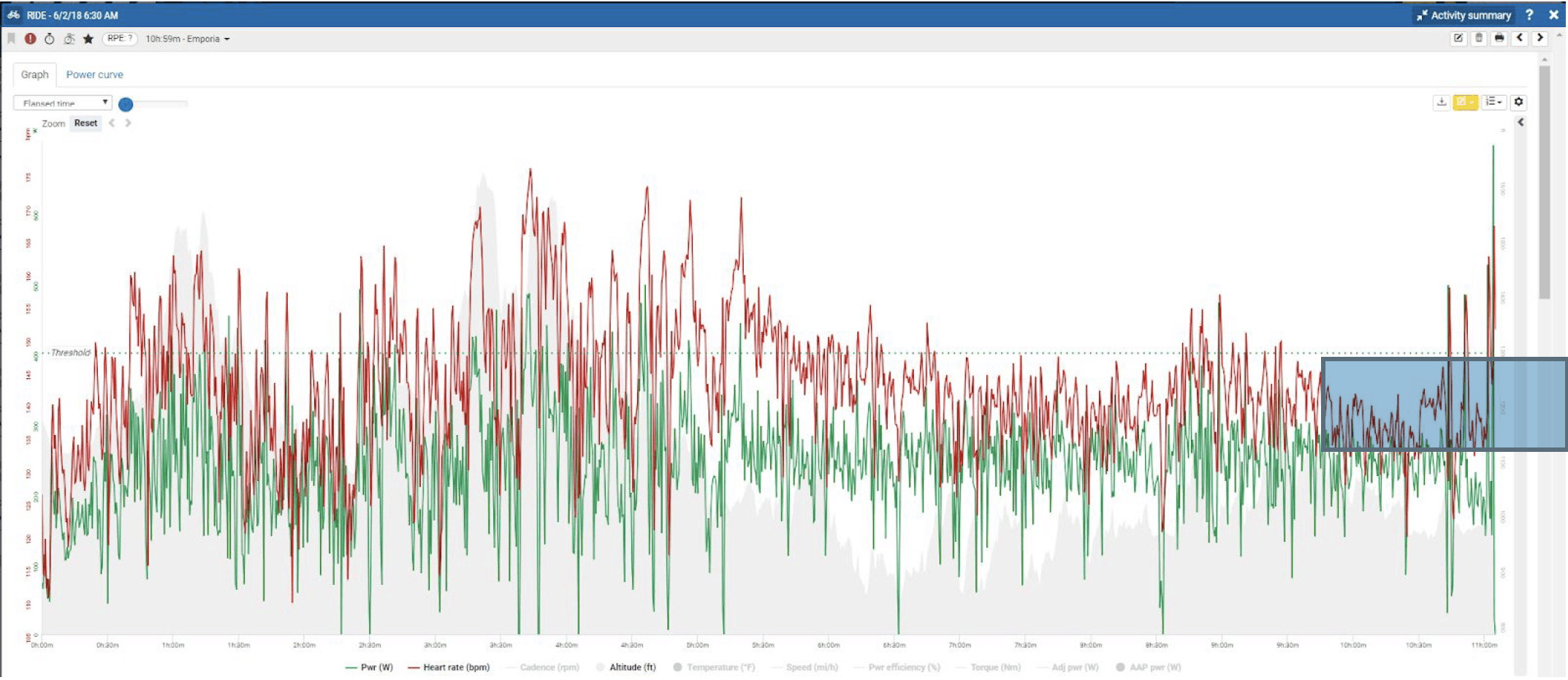Kabush & Dirty Kanza By The Numbers
- By Kate Hector
- Published: Feb 11, 2021
- Last Updated: Oct 27, 2022

Geoff Kabush is happy to have survived Dirty Kanza's 200-mile long race. It was the longest distance and most time he's ever spent on a bike. Now that it's literally done and dusted let's take a look at Dirty Kanza, by the numbers.
First, a big thanks to 3rd place finisher in the 2018 Dirty Kanza (and our favorite Canadian), Geoff Kabush, for sharing his power data as measured by his Stages R Power meter and recorded by his Stages Dash head unit.
KABUSH KANZA BREAKDOWN:
THE OVERALL RIDE:
- Rider weight: 77kg / 170lbs.
Rider height: 188cm / 74in.
Estimated threshold power: 400w
Distance: 330 km / 206 mi. (just a bit further than the distance between New York City and Baltimore).
Overall race time: 11:04:55 (just a bit less time than it might take to drive from New York City and Baltimore during rush hour).
Average speed: 30.0kph / 18.61mph
Time behind race winner, Ted King: 00:20:33
Elevation gain: 2197m / 7208ft.
Estimated threshold power: 400w
Average power: 240w
Energy spent: 9509kJ (equivalent to approximately 27 glazed cinnamon rolls from Tim Horton’s or 45 servings of Chimay Blue).
When looking at the power file, and comparing the first half of the file with the second, it’s clear that Geoff did a great job managing his nutrition and hydration.
For the first half of the race (by time, not distance), Geoff’s average power was 237w and his average power in the second half was 243w.
His average heart rate for each half was 144bpm and 140bpm respectively, indicating that he did not suffer from too much “cardiac drift” or extreme fatigue from lack of energy.
Geoff comments, “This was where I did a lot of planning coming into the race. My sponsors CamelBak and Gu Energy were a bit part of this effort. I used the CamelBak Chase Vest and I received a freshly loaded one at each aid station. I picked one up with a frozen 1.5L reservoir with GU Roctane Drink Mix, 2-3 Gu gels, 2 Chew packages, and a couple bottles of their hydration mix. I was targeting consumption of around 250g of carbs between each aid. The 2nd and 3rd leg were a little longer so I did feel things sliding around the 6-7hr mark but a coke really helped me get back on top and I was able to really finish strongly. I was surprised to see the power numbers I was able to generate in the final sprint after 11hrs.”.

THE BEST 20 MINUTES:
Adjusted power: 373w
Average cadence:70rpm
Peak 1’: 482w
Peak 5’: 424w
Peak 20’: 331w
About this 20 minutes of effort, Geoff says, “Initially I was really able to feather my effort in the larger group; use my experience to gauge when and where I could minimize any efforts to stay with the leaders. That all went out the window when I had to stop a couple times and plug my tire around the 4hr mark. I spent around 20min in a pretty precarious position trying to chase back to the fast moving lead pack. The lead pack became smaller and the race became harder soon after so there was nowhere to hide anymore. From the 5.5hr mark, it was a small group chasing into a brutal headwind almost all the way home.”
Geoff had some advice for future Dirty Kanza races (and similar type events), “ I’m definitely happy I had been doing my push-ups. People underestimate the upper body and core on such a long event. I think it was really key to finishing strong after such a long day. Other than that it was more research than training that went into DK. After 3-4hrs I think it is all the same physiologically and just comes down to proper nutritional planning. It is definitely a major undertaking and I’m really impressed by everyone who finished. If you are thinking of doing it just make sure to do the planning and have the equipment to make it through a brutal day. The atmosphere of the event is definitely worth it."
Besides the Stages R Power meter, Geoff also used his Stages Dash head unit, “I have 10 data screens on my Dash with lots of information to look at. It’s nice to have some distractions during such a long event. I was definitely looking at my 3s power to gauge my efforts in the chase, counting the distance down, and paying attention to the time to make sure I was getting my nutrition in."

Geoff’s Power file with no smoothing (1-second recording) as displayed in Stages Link. Green is power, red is heart rate, and the grey in the background is elevation. The X-axis is time.

And, this is Geoff’s Stages Power file with 120-second smoothing to better show trends throughout the race, as displayed in Stages Link. Green is power, red is heart rate, and the grey in the background is elevation. The X-axis is time. In this view, it’s apparent that there was a shift in the demand of the event at about the 5-hour mark. There were fewer opportunities to reduce power but the power output was steadier. This is reflected in Geoff’s comment that, from about that point, the group had been reduced significantly and that they were battling a headwind back to the finish.field_573492c8baf6eJust to finish Dirty Kanza requires a monumental effort. Thanks to Geoff’s Stages Power meter and Stages Dash, we can see what kind of effort is required to not only finish but also land on the podium.field_573492ecbaf6ffield_573492a5baf6dGet Dashfield_595198764fc95If you would like to check out one of Geoff’s favorite workouts, among others from Stages-sponsored athletes, go here.


KABUSH KANZA BREAKDOWN
Geoff Kabush is happy to have survived Dirty Kanza's 200-mile long race. It was the longest distance and most time he's ever spent on a bike. Now that it's literally done and dusted let's take a look at Dirty Kanza, by the numbers.
First, a big thanks to 3rd place finisher in the 2018 Dirty Kanza (and our favorite Canadian), Geoff Kabush, for sharing his power data as measured by his Stages R Power meter and recorded by his Stages Dash head unit.
THE OVERALL RIDE:
- Rider weight: 77kg / 170lbs.
Rider height: 188cm / 74in.
Estimated threshold power: 400w
Distance: 330 km / 206 mi. (just a bit further than the distance between New York City and Baltimore).
Overall race time: 11:04:55 (just a bit less time than it might take to drive from New York City and Baltimore during rush hour).
Average speed: 30.0kph / 18.61mph
Time behind race winner, Ted King: 00:20:33
Elevation gain: 2197m / 7208ft.
Estimated threshold power: 400w
Average power: 240w
Energy spent: 9509kJ (equivalent to approximately 27 glazed cinnamon rolls from Tim Horton’s or 45 servings of Chimay Blue).
When looking at the power file, and comparing the first half of the file with the second, it’s clear that Geoff did a great job managing his nutrition and hydration.
For the first half of the race (by time, not distance), Geoff’s average power was 237w and his average power in the second half was 243w.
His average heart rate for each half was 144bpm and 140bpm respectively, indicating that he did not suffer from too much “cardiac drift” or extreme fatigue from lack of energy.
Geoff comments, “This was where I did a lot of planning coming into the race. My sponsors CamelBak and Gu Energy were a bit part of this effort. I used the CamelBak Chase Vest and I received a freshly loaded one at each aid station. I picked one up with a frozen 1.5L reservoir with GU Roctane Drink Mix, 2-3 Gu gels, 2 Chew packages, and a couple bottles of their hydration mix. I was targeting consumption of around 250g of carbs between each aid. The 2nd and 3rd leg were a little longer so I did feel things sliding around the 6-7hr mark but a coke really helped me get back on top and I was able to really finish strongly. I was surprised to see the power numbers I was able to generate in the final sprint after 11hrs.”.

Adjusted power: 373w
Average cadence:70rpm
Peak 1’: 482w
Peak 5’: 424w
Peak 20’: 331w
About this 20 minutes of effort, Geoff says, “Initially I was really able to feather my effort in the larger group; use my experience to gauge when and where I could minimize any efforts to stay with the leaders. That all went out the window when I had to stop a couple times and plug my tire around the 4hr mark. I spent around 20min in a pretty precarious position trying to chase back to the fast moving lead pack. The lead pack became smaller and the race became harder soon after so there was nowhere to hide anymore. From the 5.5hr mark, it was a small group chasing into a brutal headwind almost all the way home.”
Geoff had some advice for future Dirty Kanza races (and similar type events), “ I’m definitely happy I had been doing my push-ups. People underestimate the upper body and core on such a long event. I think it was really key to finishing strong after such a long day. Other than that it was more research than training that went into DK. After 3-4hrs I think it is all the same physiologically and just comes down to proper nutritional planning. It is definitely a major undertaking and I’m really impressed by everyone who finished. If you are thinking of doing it just make sure to do the planning and have the equipment to make it through a brutal day. The atmosphere of the event is definitely worth it."
Besides the Stages R Power meter, Geoff also used his Stages Dash head unit, “I have 10 data screens on my Dash with lots of information to look at. It’s nice to have some distractions during such a long event. I was definitely looking at my 3s power to gauge my efforts in the chase, counting the distance down, and paying attention to the time to make sure I was getting my nutrition in."





















